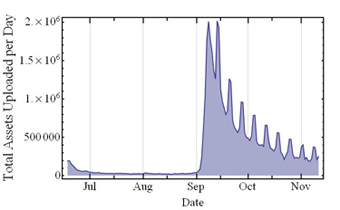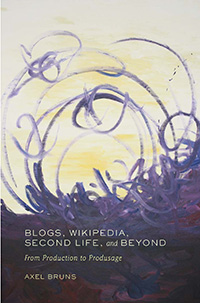You are here
Spore at 70
70 million user-generated content assets, that is. Readers of the produsage book will know that I'm very interested in Eric von Hippel's model in Democratizing Innovation of providing users with toolkits that enable them to participate in design and development processes. "Toolkits for users", he writes, "change the conditions potential innovators face. By making innovation cheaper and quicker for users, they can increase the volume of user innovation. They also can channel innovative effort into directions supported by toolkits" (147).
What von Hippel predominantly has in mind here are industrial design processes - he discusses examples ranging from the user-led design of custom semiconductor circuit boards to the collaborative development of kitesurfing equipment. Far from these fields, though, it seems to me that Maxis's computer game Spore, released last September, provides an almost perfect example of encouraging user-led innovation.
Designed by Will Wright, Spore is an open-ended, multi-stage 'evolution game' in which players progress from controlling single-cell organisms through progressively more complex animal, tribal, and civilisation stages to a final space exploration stage; along the way, they are able to create and modify their in-game characters (determining their bodyshape, attributes, and colour scheme in an editor mixing elements of Playdoh and Mr. Potato Head) as well as in-game clothing, buildings, vehicles, and related assets. Such creations are almost automatically shared with other users through the Sporepedia Website, and users' game copies will automatically download random creations from that Website to increase the diversity of the virtual universe each player encounters.
Spore was introduced over a period of two years before its launch in the northern autumn of 2008 through a series of demo videos from international games industry exhibitions (some of them featuring actor Robin Williams and other celebrities), available from YouTube and games enthusiast Websites; during 2008, finally, a subset of the Spore game itself, the Spore Creature Creator (the editor for in-game characters), was released to the public in a limited demo version as well as a full-featured version available for a nominal download fee. The editor acted, therefore, as a training tool for prospective Spore users, enabling them to develop their skills with this crucial in-game toolkit before playing the full game; in addition, it also built their familiarity with the Sporepedia Website which tracks their content creation activities, showcases their creations, highlights their in-game achievements, and enables them to follow leading content creators by subscribing to their 'Sporecasts' (RSS feeds of asset collections, of which there are now over 100,000 as well...).
 Users were therefore well-prepared for the release of the full Spore game several months later; within one day of the Spore Creature Creator launch, its users had created over 100,000 different creatures, and by the time the game proper launched, users had already contributed in excess of 1.5 million creatures - a larger number of creatures than there are different species on our planet. Today, over 70 million different assets are available in the Sporepedia (including creatures, but also buildings, vehicles, and other user-created elements). The graph to the right shows Spore's global stats on content creation - while produser activity has slowed down since the heady days of September 2008, they're still averaging some 200,000 assets per day...
Users were therefore well-prepared for the release of the full Spore game several months later; within one day of the Spore Creature Creator launch, its users had created over 100,000 different creatures, and by the time the game proper launched, users had already contributed in excess of 1.5 million creatures - a larger number of creatures than there are different species on our planet. Today, over 70 million different assets are available in the Sporepedia (including creatures, but also buildings, vehicles, and other user-created elements). The graph to the right shows Spore's global stats on content creation - while produser activity has slowed down since the heady days of September 2008, they're still averaging some 200,000 assets per day...
Quoting von Hippel:
Present practice dictates that a high-quality toolkit for user innovation will have five important attributes. (1) It will enable users to carry out complete cycles of trial-and-error learning. (2) It will offer users a solution space that encompasses the designs they want to create. (3) It will be user friendly in the sense of being operable with little specialized training. (4) It will contain libraries of commonly used modules that users can incorporate into custom designs. (5) It will ensure that custom products and services designed by users will be producible on a manufacturer's' production equipment without modification by the manufacturer. (154)
Spore addresses these requirements largely by folding them into the gameplay itself - the trial-and-error process, for example, results from players repeatedly working through the various stages of the game as they evolve their different species to the space stage; libraries of design modules are progressively made available as players clock up in-game achievements, and new 'modules' (new sets of creature eyes or claws, for example) are occasionally introduced through game engine updates.
It's how Spore addresses and builds on the last point, however, that is its most impressive achievement. Von Hippel's (re)producibility is ultimately a question of standardisation: however complex or unique a user-made, toolkit-designed asset may appear to the casual viewer, it must in the end be able to be constructed from a set of standard elements - "the heterogeneous needs of many users" must be able to "be addressed by a standard solution approach encoded in a toolkit" (162). Not only does Spore's editor achieve this in spades, as the amazing variety of Spore creatures demonstrates - it also manages to encode the instructions for constructing the asset (the DNA of a Spore creature, the blueprint of a Spore vehicle or building) as surplus information into a standard PNG image file, making them easily shareable. (And that, of course, is where the Sporepedia comes in - the central conduit distributing Spore DNA from user to user.)
70 million content assets in under half a year is an impressive record by anyone's standards. Spore demonstrates that for lessons on how to do 'user innovation' properly, one need not look any further than the computer games industry (and my colleague John Banks observed similar processes at work in the user community for the train simulator Trainz):
-
Whet users' appetite, and gear them up for becoming produsers by releasing your content creation toolkit early, even before releasing the game itself.
-
Turn content creation into a game in which more complex and challenging tasks are introduced gradually, as produsers achieve mastery of earlier stages.
-
Make the assets created in the process easily and immediately shareable.
-
Incorporate a content and advice sharing system which enables produsers to follow and learn from one another's work.
Granted: how Spore does all of this isn't entirely unproblematic - ultimately, Maxis harnesses the hive of Spore users mainly for its own benefit; the more assets are available for the game, the more attractive to prospective users it ultimately becomes. There are persistent questions over who (according to the game's licence agreement) actually owns the content users create, and with the Sims-style add-ons and expansion packs reported to be in the pipeline, it's likely that users will pay, over and over again, to remain part of the gamer community. And in the (controversial) words of Clay Shirky, perhaps Spore is simply another way of wasting our cognitive surplus now that we're watching less television.
But then again, and more importantly: Spore is a blueprint for what's possible, for how users can be harnessed and trained as produsers and innovators. Wikipedia already demonstrates what concrete beneficial outcomes this approach can achieve; Spore shows how to translate von Hippel's design toolkit model into a playful yet nonetheless incredibly productive form of participation. The next such project may do more than 'simply' entertain its players and fill Maxis's coffers - staying with the space theme, what if it's bringing Spore-style fun to NASA's Clickworkers or SETI programmes instead?
- Snurb's blog
- Log in to post comments
- 9213 reads
 Printer-friendly version
Printer-friendly version


